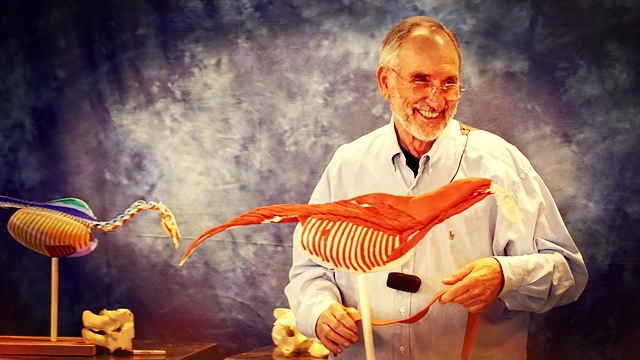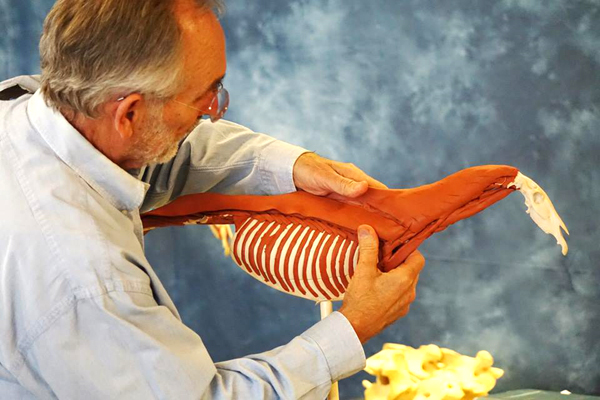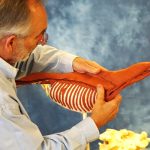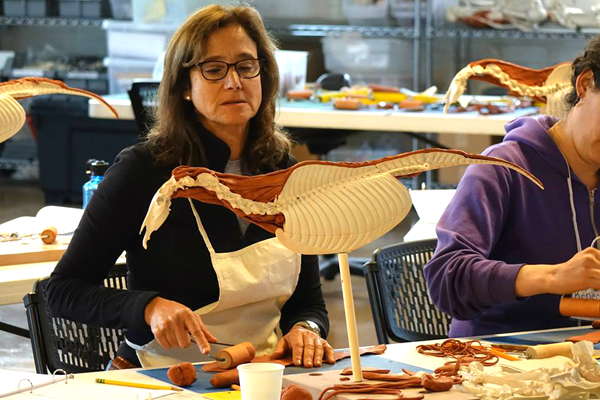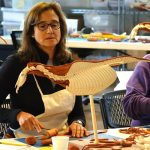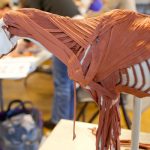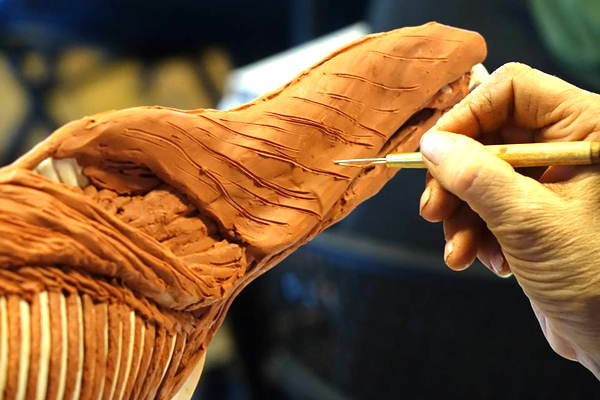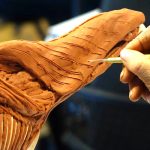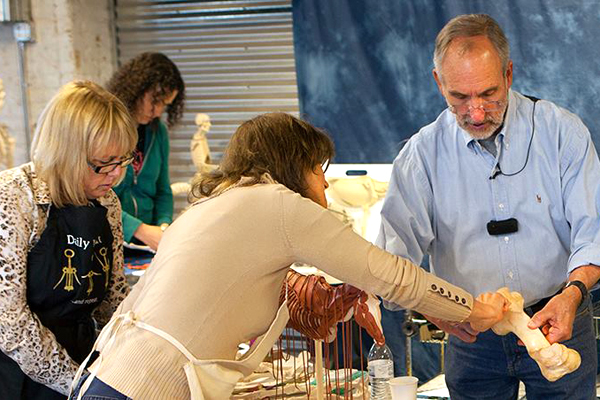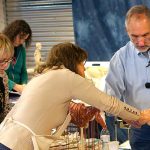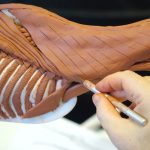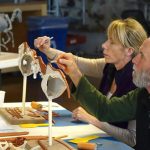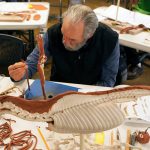For more information on Zahourek’s legendary 6-day equine workshops,
March 21-29, 2020 in Denver, contact the Anatomy in Clay Centers or Register Today!
“The anatomy is indivisible from understanding your relationship with the horse, if you ask me,” says Jon Zahourek. “And by approaching it so that human anatomy, your own body, is intimately involved with that understanding of the anatomy of your horse, then that just enhances the functional interaction.”
Jon Zahourek developed a unique educational business called the Anatomy in Clay Learning System which he built from the ground up beginning in 1977. In this system, Zahourek has created scale models of horses, humans, and other vertebrates. These specific models allow students to build directly on the skeleton. Using colored clay, they are able to form the different muscles and apply them to the skeleton, layer upon layer, with their appropriate attachment sites.
Zahourek also began a Denver-based non-profit organization called Anatomy in Clay Centers to help students learn anatomy using his innovative system and approach. The stated goal of the organization is “to empower self-discovery in each of us by forming anatomy with our own hands.”
Zahourek began as a painter and a sculptor, and early-on trained as an illustrator, as well. He spent time in Denver, Colorado and Taos, New Mexico in the 1960s and 70s. In 1977, Zahourek moved to New York City to “plunge” himself into that city’s art scene, as he says. He was immediately invited to teach artists to draw human figures “out of their heads” by the Parson’s School of Design. The need for a solid understanding of human anatomy to accomplish this task became evident to Zahourek. In order to facilitate this process, he built a 40%-of-life sized scale model of a human skeleton on which he could demonstrate surface anatomy with clay. Thus the idea, that would evolve into Zahourek’s anatomy learning system, was born. He quickly realized the power that his approach possessed to get students—and himself—learning anatomy in a way that proved easy to understand and to retain. Funding this endeavor with his art sales, he turned a quiet art project into a revolutionary method for learning anatomy.
I built a scale model of a human to begin with just to demonstrate clay muscles on it for my art students,” Zahourek says. “Just as soon I started building on it in clay, I began learning in giant bounds anatomy that I had never known. Though I had taught anatomy—somehow the process just kicked the door down between my cortical mind and my kinesthetic mind and things just kind of came together, and anatomy became absolutely understandable. What we do is take lumps of shapeless clay and form meaning in terms of whether you want to make it muscles or nerves or gut—whatever it is you want to form onto these models.”
It was not long before Zahourek saw the help his models could provide for students of comparative anatomy, and he spread his focus from humans to include other animals as well. The horse was one of the first. Its scale is 25% life-size. By varying the scale of different animals, their similarity of size makes it easy to compare their form and function.
I chose the horse because of its extreme variation [from human]” Zahourek says, “but also because they are so beautiful. I grew up in Oklahoma chasing cows on foot, unfortunately, not on horses. Taking on equine anatomy, I began to study horses really intensively…going to vet school dissections and going to lots of stables and farms where I painted many of the horses on site. That was the benefit of what I offered the artists…that they can feel the structure and intuitively feel the movement in their own body.”
“My equine model is a pretty good size…for decades I’ve taught every slip of almost every muscle in the body…minus the inner ear… building from the inside out…which is 80 percent of the anatomy—a stunning amount of anatomy, unheard of historically.”
“In these workshops, every participant disassembles a horse model, taking it down into its subsystems for clarity and simplicity of understanding. By taking this innovative to approach to learning,” Zahourek says, “the comparative anatomy and function is imminently simple and elegant. First, participants build on the axial subsystem of the head through the tail, then the branchial subsystem of the jaws and throat. Next, we build the pectoral limbs and then the pelvic limbs. In each, we build only the muscles that are “intrinsic” within each subsystem. In doing that, the anatomical logic of the muscles makes new sense when you divide anatomy into its conceptual parts.”
During the last day, equine sub-systems are assembled and extrinsic muscles are added together that connect everything. Participants see the meaning of how muscles, that are seen on the surface, fit into the whole structure.
Even after 40 years of working with these models, Zahourek’s excitement remains fully intact about their potential to help humans grasp a deep understanding of anatomy, our own and our fellow mammals. Perhaps the most curious aspect of his model mode of teaching is that the astonishing complexity of the body of humans and other animals is made simple. In building muscles, their potential function, muscle-by-muscle, is easy to comprehend—especially with feedback from the function of your own body, muscle-by-muscle, and then muscle-groups. Solving how they interact with each other is exciting. All in all, students are able to see how each simple structure plays its role in the overall body and movement of the horse.
It bounces back and forth both ways,” Zahourek explains. “So if you’re looking to communicate anatomically, physiologically, with your mount—and it seems to me it happens a lot— like the surge of data back and forth between us and these great animals…is that there is an awful lot of intelligence going on. Your body can read it before your mind can.
“I think there’s never been anything like it in terms of the amount of material and the amount of understanding that I put in their hands just because of the way I approach it going from the inside out. It means you’re solving the simplest problems first, then the next simplest problems, and so forth, instead of starting from the outside in. If you’ve built anatomy, then shazaam! real understanding.
“Right now, particularly for learning human anatomy, Anatomy in Clay Learning System is in almost 12,000 classrooms in the United States from elementary school through vet or medical schools.” Zahourek says with the horse folks who take his courses, his primary goal is to get them to “inhabit with their own body, the horse’s body, and vice-versa.”
Anatomy in Clay® Centers
2201 South Delaware, Denver, CO 80223
Telephone: 720.570.7820
E-mail: info@anatomyinclaycenters.org

